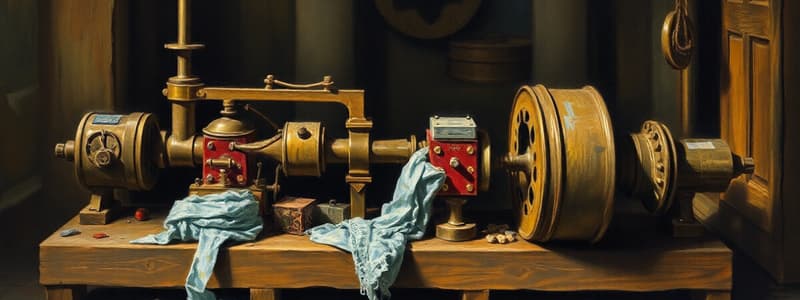Podcast
Questions and Answers
A construction worker uses a pulley system to lift a heavy beam. They apply an input force of 200 N, and the beam has a weight (output force) of 600 N. What is the Actual Mechanical Advantage (AMA) of this pulley system?
A construction worker uses a pulley system to lift a heavy beam. They apply an input force of 200 N, and the beam has a weight (output force) of 600 N. What is the Actual Mechanical Advantage (AMA) of this pulley system?
- 3 (correct)
- 0.33
- 120000
- 400
A person uses a lever to lift a rock. The distance from the fulcrum to the point where the person applies force is 2 meters, and the distance from the fulcrum to the rock is 0.5 meters. What is the Ideal Mechanical Advantage (IMA) of this lever?
A person uses a lever to lift a rock. The distance from the fulcrum to the point where the person applies force is 2 meters, and the distance from the fulcrum to the rock is 0.5 meters. What is the Ideal Mechanical Advantage (IMA) of this lever?
- 1
- 1.5
- 0.25
- 4 (correct)
A force of 50 N is applied to a box to push it across a floor for a distance of 10 meters. It takes 5 seconds to move the box this distance. How much power was exerted?
A force of 50 N is applied to a box to push it across a floor for a distance of 10 meters. It takes 5 seconds to move the box this distance. How much power was exerted?
- 100 Watts (correct)
- 250 Watts
- 1000 Watts
- 2500 Watts
Which of the following scenarios involves work being done in a scientific sense?
Which of the following scenarios involves work being done in a scientific sense?
A mechanic uses a wrench to loosen a bolt. The wrench handle is 0.25 meters long, and they apply a force of 20 N at the end of the handle. What is the work done, if the wrench rotates $\frac{1}{4}$ of a full turn?
A mechanic uses a wrench to loosen a bolt. The wrench handle is 0.25 meters long, and they apply a force of 20 N at the end of the handle. What is the work done, if the wrench rotates $\frac{1}{4}$ of a full turn?
A complex machine is designed using a combination of simple machines. It has an actual mechanical advantage (AMA) of 12. Which of the following adjustments would most likely decrease the machine's AMA?
A complex machine is designed using a combination of simple machines. It has an actual mechanical advantage (AMA) of 12. Which of the following adjustments would most likely decrease the machine's AMA?
A car engine can perform 5000 J of work in $\frac{1}{2}$ a second. How much power does it produce?
A car engine can perform 5000 J of work in $\frac{1}{2}$ a second. How much power does it produce?
Which of the following simple machines is essentially a rotating inclined plane?
Which of the following simple machines is essentially a rotating inclined plane?
Flashcards
What is 'work'?
What is 'work'?
Force applied over a distance, causing movement.
Work Formula & Units
Work Formula & Units
Work = Force × Distance; measured in Joules (J).
What is 'power'?
What is 'power'?
The rate at which work is done, measured in Watts (W).
Six Simple Machines?
Six Simple Machines?
Signup and view all the flashcards
Mechanical Advantage (MA)
Mechanical Advantage (MA)
Signup and view all the flashcards
Inclined Plane Benefit?
Inclined Plane Benefit?
Signup and view all the flashcards
How Pulleys Reduce Effort
How Pulleys Reduce Effort
Signup and view all the flashcards
IMA vs. AMA
IMA vs. AMA
Signup and view all the flashcards
Study Notes
- These notes cover work, power, simple machines, and mechanical advantage.
Work and Power
- Work equals force multiplied by distance (W = F × d).
- Joules (J) are the unit of measurement for work.
- Power is work divided by time (P = W / t).
- Watts (W) are the unit of measurement for power.
Mechanical Advantage
- Ideal Mechanical Advantage (IMA) is input distance divided by output distance.
- Actual Mechanical Advantage (AMA) is output force divided by input force.
Six Simple Machines
- Inclined Plane: Reduces the force needed to lift objects by using a sloped surface.
- Wedge: Splits materials by applying force over a distance.
- Screw: An inclined plane wrapped around a cylinder, converting rotational force to linear motion.
- Lever: Amplifies force using a rigid bar pivoting on a fulcrum.
- First-class levers, like a seesaw.
- Second-class levers, like a wheelbarrow.
- Third-class levers, like a broom.
- Pulley: Changes force direction using a wheel with a groove.
- Wheel and Axle: Reduces friction and increases force by using a wheel connected to a central rod (axle).
Simple vs. Complex Machines
- Simple Machines: Involve one basic movement.
- Complex Machines: Combine two or more simple machines, like a bicycle (wheel & axle, levers, gears).
- Both simple and complex machines reduce effort and make work easier.
Study Guide Q&A
- Work occurs when an applied force moves an object in the direction of the force.
- Power measures the rate at which work is performed.
- Mechanical Advantage (MA) is the ratio of output force to input force.
- An inclined plane reduces the required force by increasing the distance.
- Pulleys reduce effort by changing force direction.
- A screw is an inclined plane wrapped around a cylinder.
- Ideal Mechanical Advantage (IMA) relies on distance, while Actual Mechanical Advantage (AMA) accounts for real-world factors such as friction.
- A wheel and axle reduces friction for easier movement.
- Simple machines make tasks easier by spreading force over distance or changing the direction of force.
Standardized Test Questions
- Joule (J) is the SI unit for work.
- A pulley consists of a wheel with a groove.
- A wheelbarrow serves as an example of a second-class lever.
Studying That Suits You
Use AI to generate personalized quizzes and flashcards to suit your learning preferences.




